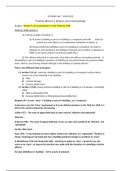Class notes
Burglary and criminal damage
- Course
- Institution
Criminal law refers to a body of laws that apply to criminal acts. The main theories for criminal law include: to deter crime, to reform the perpetrator, to provide retribution for the act, and to prevent further crimes. This document is a full outline on burglary and criminal damage with a full of...
[Show more]



